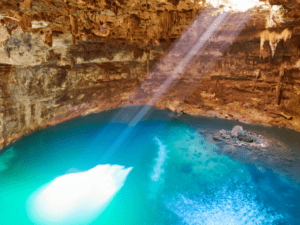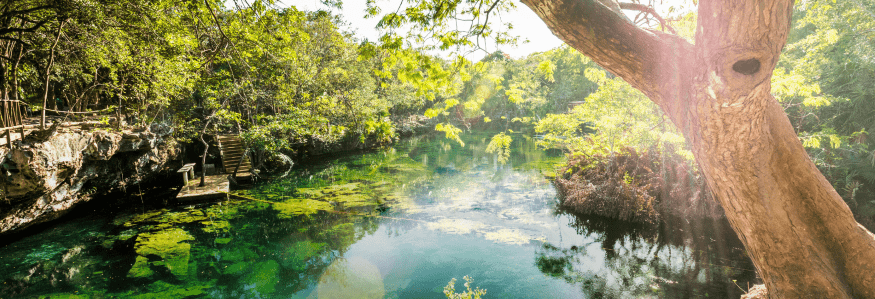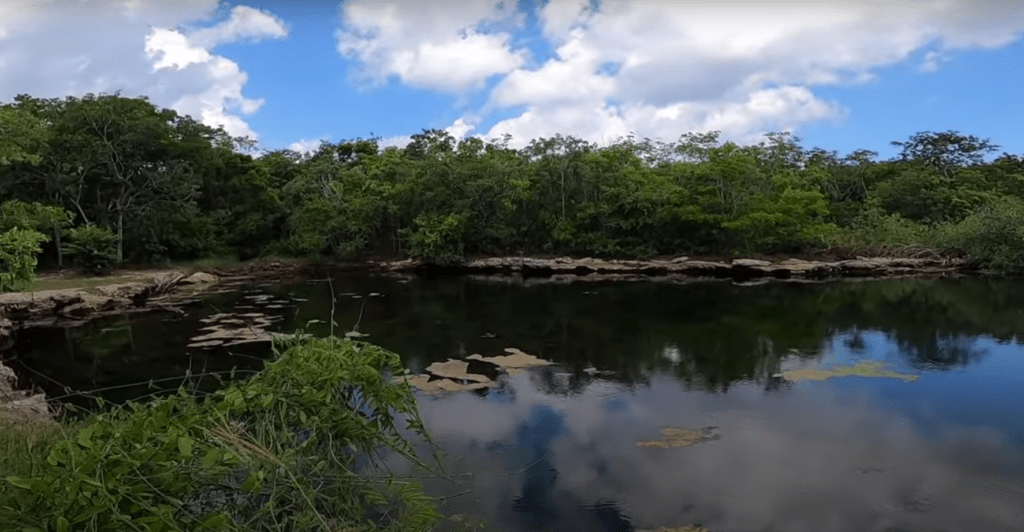Valladolid Cenotes

A Brief History of the Sacred Cenote
The Valladolid Cenote is a sacred sinkhole located in the heart of Mexico’s Yucatan peninsula. This natural wonder was formed over millions of years by the collapse of limestone bedrock, creating a deep pit filled with crystal-clear water. The name “cenote” comes from the Mayan word “dzonot,” which means “well.” The Mayans believed that these cenotes were portals to the underworld and revered them as sacred sites for their spiritual significance.
The history of Valladolid Cenote dates back to ancient times when it served as a crucial source of fresh water for the surrounding communities. However, it became even more important during the height of Mayan civilization between 600-1200 AD. At that time, it was considered one of the most important ceremonial centers in all of Mesoamerica.
The Importance to Mayan Civilization
For Mayans, water was a vital resource not just for survival but also for religious rituals. They believed that cenotes like Valladolid were inhabited by gods and spirits that controlled nature’s cycles and could bring prosperity or destruction depending on their mood.
Because these sacred wells were believed to be connected to the underworld, they also played an essential role in human sacrifices. Valladolid cenote was an essential center for religious ceremonies, including human sacrifices, particularly during droughts when it was most crucial to appease the gods for rain.
Priests would offer gifts such as jade beads and gold ornaments to win favor from their deities before throwing victims into its waters. The importance of Valladolid Cenote continued even after Spanish colonization.
It is still considered one of Mexico’s cultural heritage sites and remains an essential center for rituals among indigenous people, including the Maya. Valladolid Cenote is a unique natural wonder that deserves to be protected and revered for its cultural significance.
Its history and importance to Mayan civilization offer an insight into the cultural heritage of Mexico. Whether you visit for its spiritual significance or simply to enjoy its beauty, Valladolid cenote is truly a place like no other.
The Location
Geographical location and features of Valladolid Cenote
Located in the heart of the Yucatan Peninsula, Valladolid Cenote is a natural wonder that offers a glimpse into the awe-inspiring beauty of nature. The crystal-clear turquoise waters of the cenote are surrounded by lush vegetation and towering trees, creating a serene oasis in the midst of urban development. The cenote itself is a deep, circular pool fed by an underground river system, resulting in a refreshing and invigorating swimming experience that is unparalleled.
Surrounding landscape and flora
Beyond the shores of the cenote lie vast expanses of tropical forest and grasslands as far as the eye can see. These landscapes are teeming with life – from brightly coloured birds and butterflies to larger mammals like jaguars and tapirs. The flora is equally diverse, with towering ceiba trees providing shelter for monkeys and toucans while delicate orchids bloom on nearby trees.
All together, Valladolid Cenote’s location creates an environment suitable for those who appreciate nature’s majesty at its finest. Whether you are exploring the surrounding forests or taking a dip in its cool waters, Valladolid Cenote offers an unforgettable experience that showcases Mother Nature’s magnificence at her best.
The Formation
How was Valladolid Cenote formed?
Valladolid Cenote is a natural wonder that has fascinated geologists and scientists for centuries. The cenote was formed millions of years ago when a meteorite hit the earth, creating a massive crater.
Over time, the crater filled with water and became the cenote we see today. It’s incredible to think about how an event so long ago could create something so beautiful.
Geological composition of the cenote
The geological composition of Valladolid Cenote is truly remarkable. The water in the cenote is incredibly clear, allowing you to see all the way to the bottom.
Surrounding the water are limestone cliffs that have been carved by water over thousands of years. The rock formations around Valladolid Cenote are some of the most stunning you’ll ever see.
The rocks surrounding Valladolid Cenote come in various shades of gray and tan and have unique patterns etched into them from years of erosion. It’s amazing to think about how much time it took for these rocks to form and how much they’ve changed over time.
Understanding how Valladolid Cenote was formed and studying its geological composition can help us appreciate its beauty even more. It’s a testament to the power of nature and reminds us that sometimes, things that seem too good to be true are actually real!
The Significance
Spiritual significance to the Mayan civilization
The Mayan civilization held Valladolid Cenote in the highest regard, believing it to be a sacred portal to Xibalba, the underworld. It is said that they performed human sacrifices at this site as a way of pleasing the gods and ensuring a bountiful harvest.
While such practices may seem barbaric in modern times, we must remember that they were an integral part of Mayan culture and belief system. As an expert writer, I cannot stress enough how important it is for us to understand and respect the history and traditions of other cultures.
Cultural importance in modern-day Mexico
In modern-day Mexico, Valladolid Cenote continues to hold cultural significance as a historical and natural landmark. It serves as a reminder of the rich heritage and traditions of the Mayan people who once inhabited this land.
For locals and tourists alike, visiting Valladolid Cenote is an opportunity to connect with Mexico’s past and appreciate its natural beauty. However, I must emphasize that it is crucial for tourism efforts to be sustainable and respectful towards this sacred site.
The excessive commercialization or exploitation of Valladolid Cenote would be a disservice not only to its cultural significance but also its ecological integrity. As we reflect on Valladolid Cenote’s spiritual significance in ancient Mayan culture and cultural importance in modern-day Mexico, we should recognize our duty as visitors to respect its past while preserving it for future generations.
The Experience
Swimming and Diving in the Cenote: An Unforgettable Adventure

Valladolid Cenote is one of the most beautiful natural wonders in Mexico and a popular destination for swimming and diving enthusiasts. The crystal-clear turquoise water of the cenote is refreshing and inviting, making it an ideal spot for taking a dip on a hot summer day.
Swimming in Valladolid Cenote is an unforgettable experience that you won’t want to miss. As you glide through the clear waters, you’ll feel like you’re floating on air, surrounded by stunning rock formations and lush greenery.
If swimming isn’t your thing, then diving in Valladolid Cenote will surely get your adrenaline pumping. The underwater caves are home to an array of unique marine life such as catfish, snails, turtles, and even some species of blind fish that have adapted to living in complete darkness.
Exploring the Underwater Caves: A Thrilling Adventure
For those brave enough to venture into the depths of Valladolid Cenote’s underwater caves, there are some truly breathtaking sights to behold. The dark crevices and caverns hide a world unlike any other – stalactites dripping from above like diamonds; colorful coral reefs teeming with life; schools of fish darting past your mask; eerie shadows dancing on walls that seem too far away to touch.
Exploring these underwater caves requires courage, skill, and proper equipment. But for those who dare to take on this adventure head-on, it’s an experience that can’t be matched.
Unique Flora and Fauna Found in and Around the Cenote: A Nature Lover’s Dream
The area surrounding Valladolid Cenote is home to a wide variety of flora and fauna that can’t be found anywhere else in the world. The lush vegetation that covers the walls of the cenote creates a beautiful contrast to the blue waters, making it a perfect place for nature lovers to explore. Around the cenote, you’ll find a diverse range of animals such as iguanas sunbathing on rocks, colorful birds chirping in trees, and even some monkeys swinging from branch to branch.
You’ll also see exotic plants like cacti, bromeliads, and orchids growing wild and free. Valladolid Cenote is an amazing destination for anyone seeking adventure or looking for a one-of-a-kind experience.
Swimming and diving in its pristine waters; exploring its underwater caves; and admiring its unique flora and fauna are just some of the reasons why this natural wonder is so popular among locals and tourists alike. So pack your bags, grab your swimsuit and head down to Valladolid Cenote today – you won’t regret it!
The Legend
Mayan Legend Surrounding Valladolid Cenote
Perhaps the most fascinating aspect of the Valladolid Cenote is its deep-rooted history and importance to the Mayan civilization. According to Mayan legend, the cenote was a sacred place where gods and goddesses were thought to reside. It was believed that throwing valuable offerings such as gold, jade, and food into the cenote would appease these deities and bring good fortune to those who made these sacrifices.
But it wasn’t just a place of worship – it was also thought to be an entrance to Xibalba, otherwise known as the underworld or “place of fear” in Mayan mythology. These beliefs about the cenote were so deeply ingrained in Mayan culture that many legends and stories have been passed down through generations.
How it Has Been Passed Down Through Generations
The stories surrounding Valladolid Cenote have been passed down through oral tradition for centuries. Even today, local guides will often regale visitors with tales of the cenote’s mythical past.
But as modern technology continues to advance, many are concerned that these legends will be lost forever. It’s important that we work to preserve these stories and keep them alive for future generations.
They offer valuable insights into not only Mayan culture but also humanity’s relationship with nature and spirituality. Without them, we risk losing a crucial part of our collective history.
While some may view legends like those surrounding Valladolid Cenote as mere fairytales or superstitions, they hold immense cultural significance and should be celebrated rather than dismissed. Let us continue to learn from them and honor their legacy for years to come.
The Future
Preservation efforts for Valladolid Cenote
Valladolid Cenote is an important part of Mexico’s cultural heritage and it is essential that we take steps to preserve it. The water quality of the cenote is particularly sensitive and requires constant attention.
Any effort to preserve the cenote should include measures to protect the surrounding ecosystem as well as monitoring water quality in order to maintain a safe swimming environment. In addition, the government should work with local communities to promote responsible tourism practices that protect the natural beauty and sacred heritage of this extraordinary site.
How tourism is affecting its future

While tourism provides valuable contributions to local economies, it can also have negative impacts on sites like Valladolid Cenote. Increased foot traffic can lead to erosion, littering, and damage to structures around the site. To minimize these impacts, efforts must be made towards sustainable tourism practices that prioritize preservation over profit.
Visitors should be educated about proper conduct at the site and required to follow specific rules designed with conservation in mind. Ultimately, we need a balance between protecting this valuable cultural resource while still allowing visitors access for education and enjoyment purposes.
Conclusion
Valladolid Cenote is a natural wonder that has been an integral part of the Mayan civilization for centuries. This cenote has a unique geological formation and is home to a variety of flora and fauna.
It has cultural significance in modern-day Mexico and is a popular tourist destination. The cenote’s spiritual significance to the Mayan civilization cannot be overstated.
It was believed to be a portal to the underworld and was used for sacrificial ceremonies. The surrounding landscape and flora add to its beauty, making it one of the most stunning natural wonders in Mexico.
Valladolid Cenote is not only significant because of its beauty, but also because it represents Mexico’s rich cultural heritage. The Mayan civilization thrived in this region for hundreds of years, using the cenote as a tool for their religious practices. While tourism has brought attention to Valladolid Cenote, it also poses a threat to its preservation.
It’s important that we balance our desire to visit this beautiful site with efforts to protect it from further damage. Mexico’s cultural heritage should be celebrated and preserved so that future generations can appreciate it as well.
Valladolid Cenote serves as a reminder of our connection with nature and how it has played an important role in shaping our history and culture. Let us continue to marvel at the beauty of Valladolid Cenote while respecting its historical significance and doing our part in preserving this national treasure.
The Yucatan peninsula is full of cenotes and other adventures, make sure to check out our Yucatan destinations.


